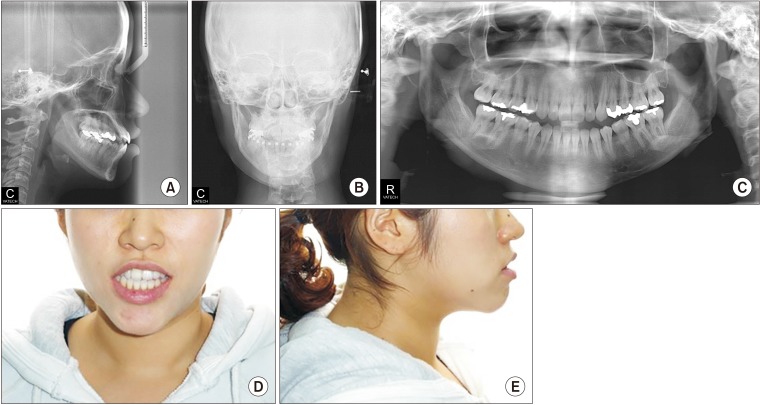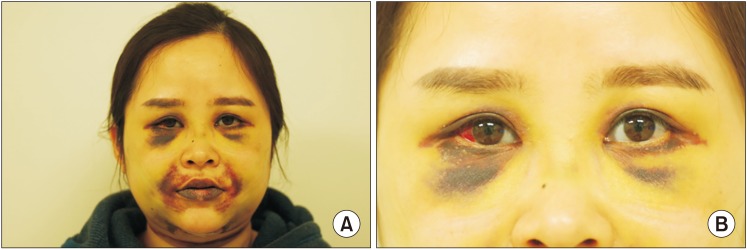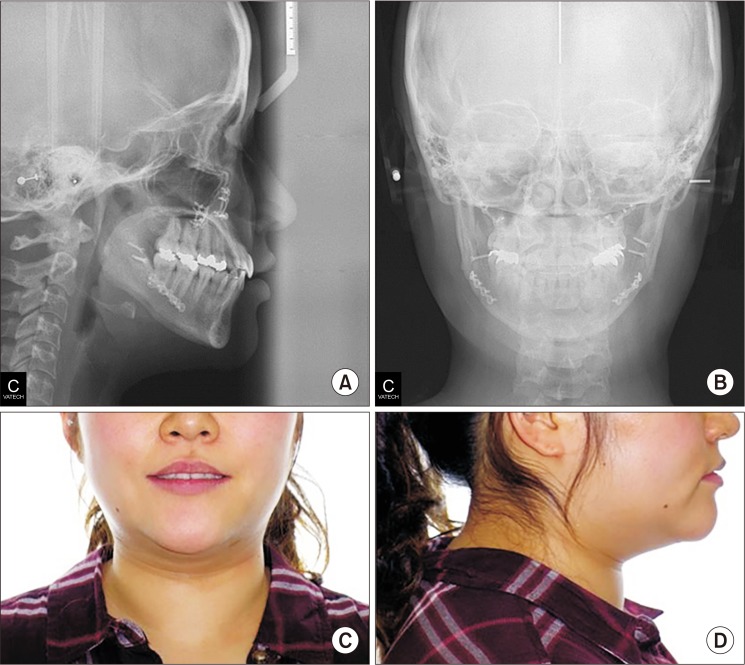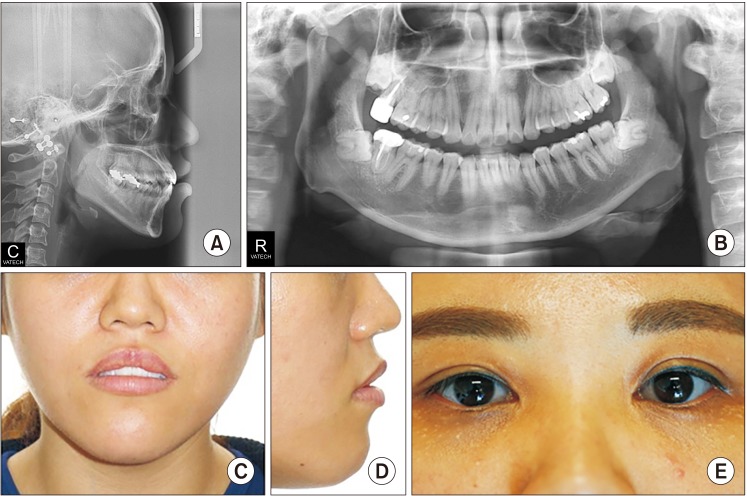J Korean Assoc Oral Maxillofac Surg.
2020 Feb;46(1):70-77. 10.5125/jkaoms.2020.46.1.70.
Osteogenesis imperfecta and combined orthodontics and orthognathic surgery: a case report on two siblings
- Affiliations
-
- 1Department of Oral and Maxillofacial Surgery, Asan Medical Center, Seoul, Korea. mfsjjh@unitel.co.kr
- 2Private Clinic, Seoul, Korea.
- KMID: 2471115
- DOI: http://doi.org/10.5125/jkaoms.2020.46.1.70
Abstract
- Osteogenesis imperfecta is a heterogeneous group of connective tissue diseases that is predominantly characterized by bone fragility and skeletal deformity. Two siblings with undiagnosed type I osteogenesis imperfecta underwent orthognathic surgery for the treatment of facial asymmetry and mandibular prognathism. The authors report two cases of combined orthodontics and orthognathic surgery in patients with type I osteogenesis imperfecta, mandibular prognathism, and facial asymmetry.
MeSH Terms
Figure
Reference
-
1. Sillence DO, Senn A, Danks DM. Genetic heterogeneity in osteogenesis imperfecta. J Med Genet. 1979; 16:101–116. PMID: 458828.
Article2. Marini JC, Forlino A, Cabral WA, Barnes AM, San Antonio JD, Milgrom S, et al. Consortium for osteogenesis imperfecta mutations in the helical domain of type I collagen: regions rich in lethal mutations align with collagen binding sites for integrins and proteoglycans. Hum Mutat. 2007; 28:209–221. PMID: 17078022.
Article3. Körkkö J, Ala-Kokko L, De Paepe A, Nuytinck L, Earley J, Prockop DJ. Analysis of the COL1A1 and COL1A2 genes by PCR amplification and scanning by conformation-sensitive gel electrophoresis identifies only COL1A1 mutations in 15 patients with osteogenesis imperfecta type I: identification of common sequences of null-allele mutations. Am J Hum Genet. 1998; 62:98–110. PMID: 9443882.
Article4. Tournis S, Dede AD. Osteogenesis imperfecta: a clinical update. Metabolism. 2018; 80:27–37. PMID: 28625337.5. Rosén A, Modig M, Larson O. Orthognathic bimaxillary surgery in two patients with osteogenesis imperfecta and a review of the literature. Int J Oral Maxillofac Surg. 2011; 40:866–873. PMID: 21459557.
Article6. Osteogenesis imperfecta: the brittle bone syndrome. Nurs RSA. 1987; 2:17–23. 407. O'Connell AC, Marini JC. Evaluation of oral problems in an osteogenesis imperfecta population. Oral Surg Oral Med Oral Pathol Oral Radiol Endod. 1999; 87:189–196. PMID: 10052375.8. Schwartz S, Tsipouras P. Oral findings in osteogenesis imperfecta. Oral Surg Oral Med Oral Pathol. 1984; 57:161–167. PMID: 6583624.
Article9. Chang PC, Lin SY, Hsu KH. The craniofacial characteristics of osteogenesis imperfecta patients. Eur J Orthod. 2007; 29:232–237. PMID: 16971690.
Article10. Waltimo-Sirén J, Kolkka M, Pynnönen S, Kuurila K, Kaitila I, Kovero O. Craniofacial features in osteogenesis imperfecta: a cephalometric study. Am J Med Genet A. 2005; 133A:142–150. PMID: 15666304.
Article11. Aizenbud D, Peled M, Figueroa AA. A combined orthodontic and surgical approach in osteogenesis imperfecta and severe Class III malocclusion: case report. J Oral Maxillofac Surg. 2008; 66:1045–1053. PMID: 18423300.
Article12. Tashima H, Wattanawong K, Ho CT, Wen-Ching-Ko E, Nguyen A, Lo LJ. Orthognathic surgery considerations for patients with undiagnosed type I osteogenesis imperfecta. J Oral Maxillofac Surg. 2011; 69:2233–2241. PMID: 21398007.
Article13. Ormiston IW, Tideman H. Orthognathic surgery in osteogenesis imperfecta: a case report with management considerations. J Craniomaxillofac Surg. 1995; 23:261–265. PMID: 7560115.
Article14. Cole NL, Goldberg MH, Loftus M, Kwok V. Surgical management of patients with osteogenesis imperfecta. J Oral Maxillofac Surg. 1982; 40:578–584. PMID: 6955473.
Article15. Morton ME. Excessive bleeding after surgery in osteogenesis imperfecta. Br J Oral Maxillofac Surg. 1987; 25:507–511. PMID: 3500744.
Article16. Bell RB, White RP Jr. Osteogenesis imperfecta and orthognathic surgery: case report with long-term follow-up. Int J Adult Orthodon Orthognath Surg. 2000; 15:171–178. PMID: 11307196.17. Keegan MT, Whatcott BD, Harrison BA. Osteogenesis imperfecta, perioperative bleeding, and desmopressin. Anesthesiology. 2002; 97:1011–1013. PMID: 12357173.
Article18. Kindelan J, Tobin M, Roberts-Harry D, Loukota RA. Orthodontic and orthognathic management of a patient with osteogenesis imperfecta and dentinogenesis imperfecta: a case report. J Orthod. 2003; 30:291–296. PMID: 14634166.
Article19. Lindahl K, Langdahl B, Ljunggren Ö, Kindmark A. Treatment of osteogenesis imperfecta in adults. Eur J Endocrinol. 2014; 171:R79–R90. PMID: 24760541.










